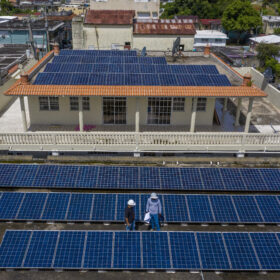In Texas’ red-hot solar market, you no longer need a power purchase agreement (PPA) to get financing for your project. In the Lone Star State a new business model of building solar plants to sell power on the wholesale market, with this sale underwritten by hedges, is emerging. What’s more important is that these projects are getting the cash needed to go forward.
But as is often the case with business model developments, the new model of hedges is far from replacing the PPA. As evidence of this, yesterday Cubico Sustainable Investments announced that it has reached financial close on the 162 MW Wagyu solar project in Brazoria County on Texas’ Gulf Coast, which holds both a hedge and a PPA.
Starbucks is buying a portion of the electricity generated by the plant under a 15-year corporate PPA, while BP is supplying a 12-year physical hedge. According to Cubico the PPA will cover 40% of the project’s output and the hedge 60%, meaning that most of the electricity from this project is not covered by a PPA.
And Cubico is wasting no time in getting the project built; engineering, procurement and construction contractor Renewable Energy Systems has already started building Wagyu, and the project is expected to become fully operational in the third quarter of 2020.
Wagyu is the fourth project to reach financial close in a 580 MW portfolio of solar projects that Cubico bought from Cypress Creek Renewables in January, with the other three located in the Carolinas. Cypress Creek is staying on to provide operations & maintenance services to Wagyu, and also built the 106 MWdc Palmetto Plains solar project. Palmetto Plains is one of the three it sold to Cubico and the largest single-site solar plant to go online in South Carolina to date.
Future of hedges?
pv magazine has identified at least three other large solar projects in Texas which hold hedges, including the 200 MW Holstein project in west-central Texas and the 240 MWac Misae project in the Texas Panhandle, and at least one of the projects in the 1.7 GWdc portfolio that Intersect Power is building in the state.
It is less clear how much of a future this business model has. In an interview with pv magazine, Starwood Energy CEO Himanshu Saxena noted that it is more difficult to raise money with a hedge than with a PPA, and has suggested that this model has emerged at least in part due to need to get projects underway to secure the full 30% Investment Tax Credit (ITC) before it steps down.
“Some developers are saying – I’ll take a $20 hedge in order to get tax equity,” says Saxena.
However, merchant solar – plants selling into the wholesale market with no power contract – is emerging as a business model in other nations. This suggests that the future of selling power from solar won’t necessarily look like the past.
Update: This article was updated at 12:37 PM U.S. East Coast time on October 17 to include numbers on how much of the electricity generated by the Wagyu project is covered by a hedge, and how much is covered by a PPA.
This content is protected by copyright and may not be reused. If you want to cooperate with us and would like to reuse some of our content, please contact: editors@pv-magazine.com.








By submitting this form you agree to pv magazine using your data for the purposes of publishing your comment.
Your personal data will only be disclosed or otherwise transmitted to third parties for the purposes of spam filtering or if this is necessary for technical maintenance of the website. Any other transfer to third parties will not take place unless this is justified on the basis of applicable data protection regulations or if pv magazine is legally obliged to do so.
You may revoke this consent at any time with effect for the future, in which case your personal data will be deleted immediately. Otherwise, your data will be deleted if pv magazine has processed your request or the purpose of data storage is fulfilled.
Further information on data privacy can be found in our Data Protection Policy.